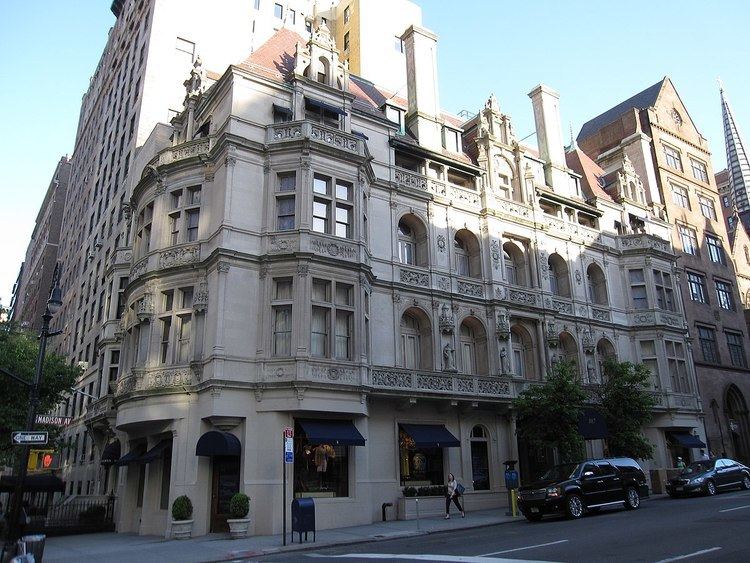Name Gertrude Waldo Died 1914 | Children Rhinelander Waldo | |
 | ||
People also search for Rhinelander Waldo, Alexander Mackintosh, Francis H. Kimball | ||
Gertrude Rhinelander Waldo (c. 1837 – May 27, 1914) was an American heiress known for commissioning the Rhinelander Mansion located in Manhattan at 867 Madison Avenue on the south-east corner of 72nd Street, designed in the 1890s by Kimball & Thompson and completed in 1898. According to most sources, she never lived in the mansion, but chose to reside with her sister in a row house across the street from the mansion.
Biography
Gertrude Rhinelander came from a family that had resided in New York City since the 17th century and was born around 1837. She married stockbroker Frank Waldo in 1876, despite the fact that he had been bankrupted during the Panic of 1873. In May 1877, she gave birth to Rhinelander Waldo, a future Fire and Police Commissioner of New York. Her husband Frank died in 1878. She received an inheritance in 1882 valued at $360,000 that consisted largely of real estate. By 1889 she had been in a relationship with lawyer Charles Schieffelin. She sued him in 1899 to reclaim $12,000 she said he had misappropriated from her that he said he was going to invest the money in various railroad securities. In a counterclaim, Schieffelin said that he had invested the money as directed and that the two of them were going to be married. Waldo responded that she would never have married Schieffelin because of his earlier divorce.
She bought a piece of property located at the corner of 72nd Street and Madison Avenue in 1882, announcing plans to construct a home that one journal called "quite unique in design". However, she did not go ahead with construction and lived with her sister Laura V. Rhinelander for many years in a row house on the opposite side of 72nd Street. Construction of the mansion was started in 1894 while she was living at the Savoy Hotel. She sold some of the property that she had inherited around 1896 and used the proceeds to cover a portion of the construction costs of two new adjoining homes on the property, which totaled $340,000, with the remaining balance in a $195,000 mortgage. Completed by 1898, the four-story house, which included a ballroom lit by 1,000 light bulbs and furnished at a cost of $1 million, was never occupied during Gertrude Rhinelander Waldo's life. It was assumed Rhinelander and her husband would move in upon returning from a European trip in 1898 (when construction was nearing completion), but not only did they not move into the residence, much of the rare European furnishings were never unpacked, and remained in the crates on the lower floors, as they came from the steamer.
Later, facing financial difficulties including owing large amounts on the two homes, Rhinelander reached an agreement to sell the house through a broker, but reneged on the deal when the papers effecting the transfer were ready to be signed, and said "I don't think I'll sell" and walked out on the offer. By December 1909 it was announced that the dilapidated structure was to be placed up for auction January 12, 1910, in order to satisfy a $10,000 judgment, $9,221 in unpaid taxes, and a prior $150,000 mortgage. According to available articles, Rhinelander was apparently able to re-purchase the property and two houses at auction and retain ownership for one more year, though they remained unoccupied and non-revenue generating.
In September 1911 Rhinelander finally let one of the mansions go at foreclosure, the smaller 72nd Street house, in order to partially cover judgments against her. In exchange for loans to further reduce her obligations, Rhinelander also transferred ownership of the larger Madison Avenue home to her sister, Laura V. Rhinelander, along with other property that Waldo owned in Lower Manhattan on Washington Street and Barclay Street.
In 1915, The New York Times reported that at the time of her death on May 27, 1914, Rhinelander was over $135,000 in debt, consisting primarily of a pair of loans she received from the L. V. Rhinelander Estate.
The Rhinelander Mansion was vacant until 1921 when it was subdivided into commercial use on the street level and two apartments on the four floors above. It now houses the flagship men's clothing store of Polo Ralph Lauren that took 18 months to renovate in 1983 at a published cost of $14–15 million.
